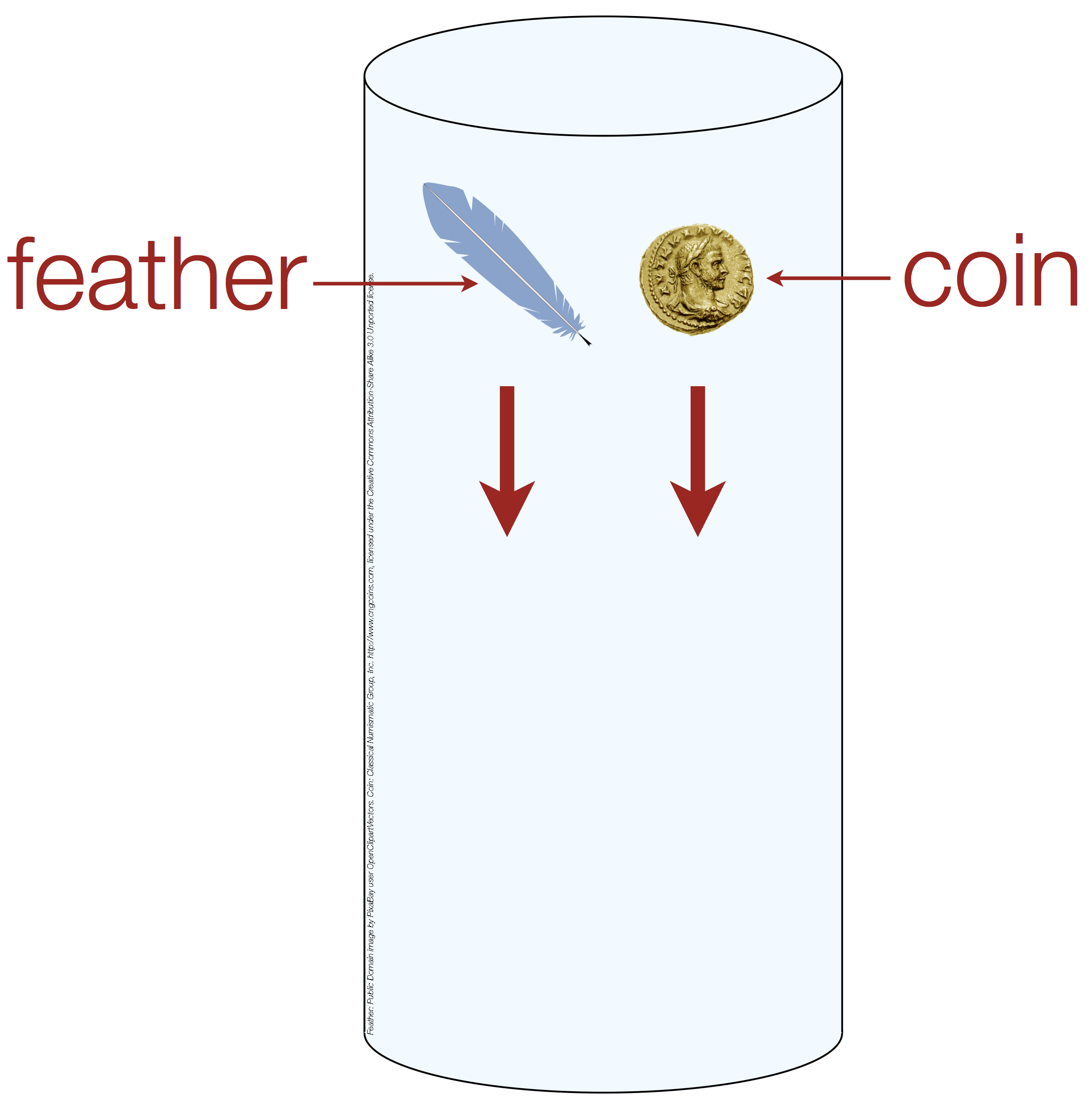November 21, 2015 Filed in:
ArticlesSaara Naudts, OAPT Contest Editor, Physics Teacher North Park SS
Sara.naudts@peelsb.com
The “Common Sense” Problem
Students arrive to your class equipped with prior knowledge, life experiences, and an understanding of how the world works. They have drawn their own conclusions on how observations can be explained; unfortunately, often their common sense is not correct. While teaching a new topic may be difficult, it is far more challenging trying to undo students’ misconceptions and false ideas about the world. According to Hestenes (2006), most often students simply modify their existing understanding to accommodate the new concepts rather than learn the correct knowledge, which leads to smorgasbord of right terminology, in partially accurate theories, and deeply-rooted misconceptions.
Example of a Student’s Misconception
Let’s look at an example from the 2015 OAPT Grade 11 Contest.
A coin and a feather are released from rest in a vacuum as shown.

Which of the following statement(s) about this experiment is/are TRUE?
I. The masses of the coin and the feather are identical in vacuum.
II. The coin and the feather fall with the same acceleration in vacuum.
III. The force of gravity acting on the coin is equal to the force of gravity on the feather.
A) I only B) II only C) III only D) II and III only E) I, II and III
Out of 934 participants, 41% of students correctly selected answer B, but an astonishing 38% chose answer D. Students clearly understand that the masses of the objects are different and that objects fall at the same rate. However, the majority of students still do not understand that the force of gravity on the respective objects is different! While students have probably watched a demo or video of this, can state the difference between mass and weight, and can calculate
FG=mg, almost two-thirds do not truly understand the concept of mass versus weight.
Concept Inventory - A Thoroughly Reviewed Tool to Check for Understanding
It is quite possible for students to successfully complete a summative evaluation, but still retain their misconceptions. A great tool to verify if students really understand a specific concept is a Concept Inventory (CI).
A Concept Inventory is a criterion-reference test, designed to evaluate whether a student has gained mastery over a specific set of concepts. By approaching the assessment of concept retention multi-directionally, we can ensure students’ full comprehension of important concepts, weeding out the underlying misconceptions.
According to Harvard University, nearly 80% of physics students can state Newton’s 3
rd law at the beginning of their course, but Force CI data demonstrates that less than 15% of them fully understood the concept — even at the course’s conclusion.
The questions of a CI focus on intuitive comprehension, independent of knowledge of the terminology or numerical modelling. They are intended for pre-and post-testing, and as such, evaluate the success of different teaching approaches. Research shows that traditional teaching methods are ineffective at uprooting misconceptions.
How can YOU use Concept Inventories to Help Improve Your Students’ Understanding?I would first recommend that you complete the CI yourself. It is not uncommon for instructors to have their own misconceptions, which then in turn will be passed onto their students. Then, give the CI to your students at the beginning of the unit and at the end. When comparing pre- and post-instructional data, there should be a significant improvement between the results. If this isn’t so, you know that you should change or augment your instruction around that particular topic. A student has not mastered a concept unless they get a minimum of 80%. Any score less than that means more work needs to be done to weed out those tough preconceived incorrect ideas. As you modify your practice, you will have clear evidence that the changes are helping.
Examples of Concept Inventories
CIs are available in a variety of topics in science, math, and engineering. Most of them will require a password, but that can easily be acquired when you email the contact listed on the website. Some good examples to start with are the Force Concept Inventory (FCI), Kinematics Graphing, and Electric Circuits. Concept Inventories are an excellent tool to evaluate students’ mastery of the topic as well as evaluate one’s own teaching practices. If you have any further questions, please contact me.
Here are some links to a variety of CIs:
http://www.asbmb.org/uploadedFiles/Education/TeachingStrategies/Concept_Inventory/Physics%20Concept%20Inventories.pdf References
Hestenes D., Wells M., Swackhamer G. (1992). Force Concept Inventory. Published in: The Physics Teacher, Vol. 30, March 1992, 141-158.
http://modeling.asu.edu/R&E/FCI.PDF Hestenes, D. (2006). Notes for a Modelling Theory of Science, Cognition and Instruction. Retrieved October 1, 2010, from
http://modeling.asu.edu/R&E/Notes_on_Modeling_Theory.pdf.
Tags: Pedagogy


